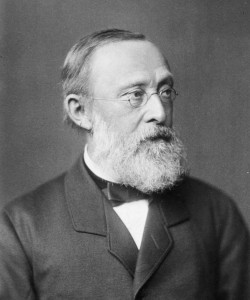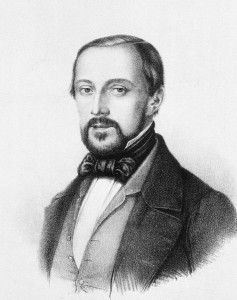Rudolf Virchow played a large social and political role in not only Berlin society, but the whole of Prussia and the world. Outside of his contributions to science, Virchow’s political activism is often overlooked in history. He was an opponent of racism and publically denounced the ideas of an “Aryan” or “German” race which is somehow superior to other “races.” Virchow published scientific findings of craniometry early on in 1885, where his results of an analysis of almost 7 million school children’s hair, skin, and eye color contradicted contemporary racist theories.
Virchow also had profound influence over the global scientific community, and he was one of the most outspoken opponents to Darwin’s theory of “descent with modification”. While incorrect, this dissent resulted in more discussion and research to discover the details of evolution.
While many lauded Virchow as the “Pope of Medicine” due to the new perspectives he offered the medical field, he disagreed with germ theory. Instead, Rudolf proposed that social and economic equality were the cause of disease and epidemics. Virchow famously stated in his Report on the Typhus Outbreak of Upper Silesia that the path to solving and containing the outbreak was not through drug treatments or minor law changes, but only through radical action of “a full and unlimited democracy and education, freedom and prosperity” which would promote the advancement of an entire population. Rudolf Virchow was extensively involved in international medicine and at the forefront of the field of epidemiology, focused on improving the health of people through social and economic change.

Virchow’s Illustrations of Cells and Cellular Pathology
Virchow’s disbelief in microbial organisms as intracellular pathogens was stemmed from his important research in cancer. He was the first to characterize the cellular pathology of leukemia in a 1845 paper. Virchow recognized that each cell stems from another cell and continued on to
Rudolf believed that every ailment stemmed from disease of the cells; he called this new field of study cellular pathology.
In addition to the field that he created, Virchow made monumental scientific discoveries and coined many new terms. He was the first to visualize cells present in bones and connective tissues, as well as describing myelin. In pathophysiology, Virchow made great strides by describing the mechanism of pulmonary thromboembolisms through the discovery of blood clots forming in venous thrombi before traveling to the pulmonary arteries. Additionally, he made the connection of diseases that spread from animals to humans–zoonoses.
Beginning in 1847, Virchow and a colleague founded a pathology journal, Archives for Pathological Anatomy and Physiology and Clinical Medicine. He continued to edit this journal until his death. Since then, it has been renamed to Virchow’s Archive and is still a leading source of prominent research in pathology. In 1854, he also developed Handbook of Special Pathology and Therapeutics, which became a model for later scientific and medical handbooks published in Europe.

A street named for Virchow at the Charite Hospital in Berlin.
Virchow also had a profound effect on medical education in Prussia. The first chair of pathological anatomy in Prussia was created for him in 1849. When the University of Berlin asked him to take a chair in 1856, he did so under the stipulation that a new pathological institution would be built there. In 1858, he published a collection of his lectures called Cellular Pathology. Throughout his career as a professor, Virchow delivered many lectures in the Charite hospital where he built an extensive pathological specimen collection. He also taught many physicians who would go on to great things, including two of the four founders of John Hopkins. Virchow was a proponent of physicians also acting as researchers and encouraged his students to spend more time working with microscopes, as well as conducting experiments on animals.

The lecture hall at Charite, where Virchow gave a speech the night before his 80th birthday. The room was bombed during WWII and has been preserved.
Although most of his early work involved pathology and public health, Virchow spent the latter portion of his life doing anthropological work. His research in this field was recognized when he was elected to the Prussian Academy of Science in 1873.

The Reichstag, where Virchow served from 1880 to 1893
In 1859 Rudolf Virchow became a member of the Municipal council of Berlin where he began his career as a civic reformer. He was made the Progressive Party leader the same year he was elected to the Prussian Diet during the tumultuous time of the 1860s, and began to immediately clash with Bismarck upon his appointment to Minister President in 1862. During his membership of the Reichstag from 1880 to 1893, Virchow was a constant proverbial thorn in Bismarck’s side and fought him on almost every topic due to ideological differences. This difference is exemplified in each man’s’ participation in the Revolution of 1848–Bismarck tried to put it down while Virchow fought on the side of the rebels and lost this prominent position at the Charite due to his involvement. This rivalry culminated in the infamous Sausage Duel between the two men in 1965 over a debate on the funding for the navy. Bismarck challenged Virchow the next day to a duel, but as the one challenged Virchow was allowed to choose the weapons, and he chose two seemingly-alike sausages. one of the sausages was filled with trichinae (a worm that causes zoonotic disease, which is deadly) and the other a normal sausage. Virchow then asked Bismarck to choose his weapon and eat it, then he will do the same. Though this proposition fit within dueling regulations of the time, Bismarck’s representatives refused it and thus no duel was fought.




 is regarded as the foundation of modern pathology and is still referenced today. Rudolf was the first person in history to name and document various diseases such as leukemia, embolism, and thrombosis. He also was the first user of such terms as chromatin, agenesis, and spina bifida. Rudolf developed the first comprehensive guidelines for autopsy using surgery and microscopic examination of all body level cells. One of his most important discoveries, one which affected Berlin directly, was his discovery of the transmission cycle of roundworm common in Europe which established the practice of meat inspection. When Rudolf died in 1902 he was called the “Pope of medicine” by his colleagues due to his founding of social medicine and advancement of public health.
is regarded as the foundation of modern pathology and is still referenced today. Rudolf was the first person in history to name and document various diseases such as leukemia, embolism, and thrombosis. He also was the first user of such terms as chromatin, agenesis, and spina bifida. Rudolf developed the first comprehensive guidelines for autopsy using surgery and microscopic examination of all body level cells. One of his most important discoveries, one which affected Berlin directly, was his discovery of the transmission cycle of roundworm common in Europe which established the practice of meat inspection. When Rudolf died in 1902 he was called the “Pope of medicine” by his colleagues due to his founding of social medicine and advancement of public health.